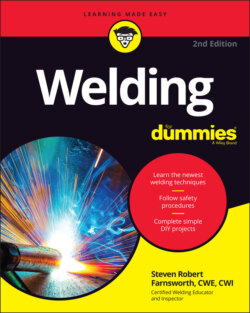Читать книгу Welding For Dummies - Steven Robert Farnsworth - Страница 32
THE MANY PROPERTIES OF METALS
ОглавлениеIt’s a little hard to believe how many different kinds of metals are out there. Metals run the gamut from tungsten, which is one of the hardest materials on Earth, to mercury, which is a liquid at room temperature. Here are a few of the physical properties of metals that combine in different ways to make metals unique.
Strength: How much external force the metal can take without breaking.
Ductility: The ability to change shape without breaking.
Magnetism: Some metals (like steel) are magnetic; others (like aluminum) aren’t.
Hardness: The resistance of a metal to being damaged when another metal is applied to it.
Resistance to oxidization: When metals combine with oxygen, they become oxidized. That’s what causes steel to rust, for example. Some metals — tungsten, for instance — are very resistant to oxidization.
Electrical conductivity: Some metals conduct electricity much more efficiently than others. For example, silver is an incredible conductor of electricity, but stainless steel doesn’t conduct well at all.
Melting point: Every metal has a melting point — the temperature at which the metal turns from a solid to a liquid. This property is critical in welding because, of course, you’re trying to melt metal. Tungsten has the highest melting point; you need temperatures of 6,170 degrees Fahrenheit to melt tungsten. That’s remarkably high compared to, say, tin, with a melting point of only 450 degrees Fahrenheit.
For more great information on steel, check out the American Iron and Steel Institute’s website at www.steel.org.
